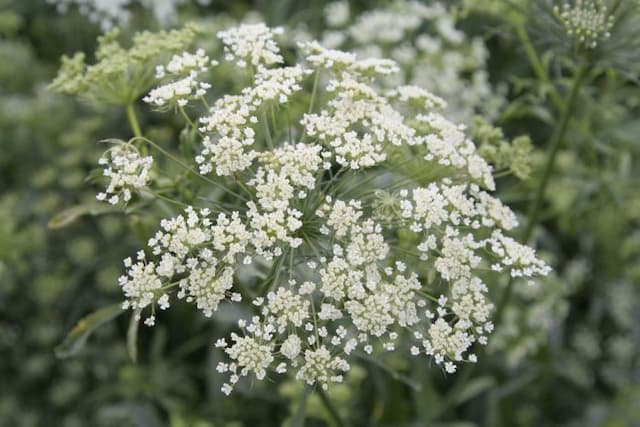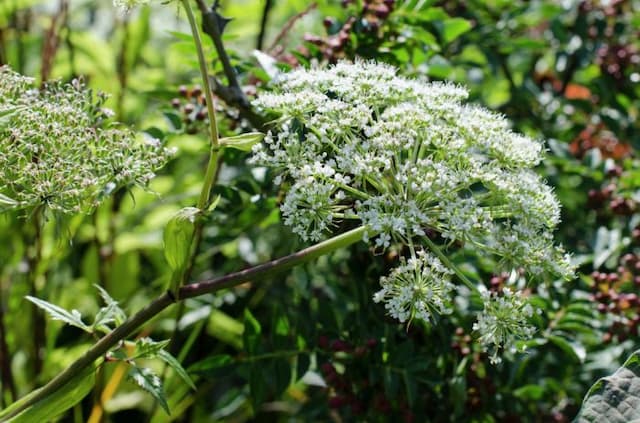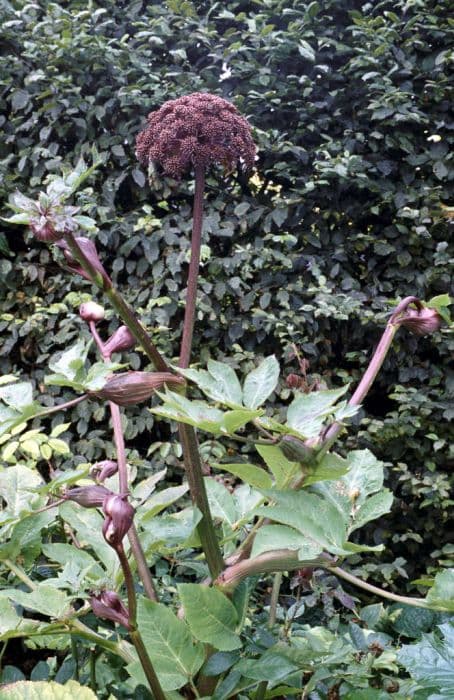Great Masterwort Astrantia major

ABOUT
Astrantia major, commonly known as Great Masterwort, is a perennial plant distinguished by its unique and intricate flowers. The bloom appears as a pin-cushioned center, formed by a tight cluster of tiny florets, usually pale pink or white, and surrounded by a ruff of papery bracts, which can be greenish, pinkish, or a reddish hue. These bracts give the flowers a star-like appearance, resembling a classic, old-fashioned nosegay. The foliage of the Great Masterwort is deeply divided and palmately lobed, with each section of the leaf having a slightly serrated edge, creating an attractive mounded form. The leaves are a lush green color, providing a lovely contrast to the delicate flowers. The plant often has a branched habit, with each stem bearing a single flower head at its top. Its overall look can add an air of whimsy and antiquity to garden settings.
About this plant
 Names
NamesFamily
Apiaceae
Synonyms
Great Masterwort, Masterwort, Hattie's Pincushion, Melancholy Gentleman, Large Masterwort
Common names
Astrantia carinthiaca, Astrantia caucasica, Astrantia major var. involucrata, Astrantia major var. rosea, Astrantia major var. purpurea, Astrantia major subsp. involucrata, Astrantia major subsp. major, Astrantia colchica, Astrantia trifida, Astrantia austriaca, Astrantia carniolica, Astrantia pallida, Astrantia helleborifolia, Astrantia major f. discolor, Astrantia maxima, Astrantia carniolica var. austriaca.
 Toxicity
ToxicityTo humans
Great Masterwort (Astrantia major) is not generally considered toxic to humans. There is little information suggesting any toxicity from ingesting this plant, and it does not typically cause poisoning. However, as with any plant, individual sensitivities can vary, and it's always prudent to avoid ingesting plants or plant parts unless they are known to be safe and are intended for human consumption.
To pets
Great Masterwort (Astrantia major) is not commonly known to be toxic to pets such as cats and dogs. There is limited information regarding its toxicity in animals, but it is not typically listed as a poisonous plant for pets. However, as with any non-food plant, it’s wise to prevent pets from ingesting plants as individual animals might have different reactions or could experience gastrointestinal upset.
 Characteristics
CharacteristicsLife cycle
Perennials
Foliage type
Deciduous
Color of leaves
Green
Flower color
Varies
Height
2 feet (60 cm)
Spread
1 foot (30 cm)
Plant type
Herb
Hardiness zones
5
Native area
Europe
Benefits
 General Benefits
General Benefits- Attracts Pollinators: Astrantia major, commonly known as Great Masterwort, is beneficial for gardens as it attracts pollinators like bees and butterflies, helping to promote biodiversity.
- Ornamental Value: This plant adds ornamental value to gardens with its beautiful, unique star-shaped flowers and attractive foliage, enhancing the aesthetic appeal of any landscape design.
- Low Maintenance: Great Masterwort is known for being low maintenance, requiring minimal care once established, making it a practical choice for gardeners.
- Drought Tolerant: It can tolerate periods of dryness once it is established, which is advantageous in regions with water restrictions or in xeriscaping.
- Shade Tolerance: This plant can thrive in partial shade, providing an option for planting in spots that do not receive full sunlight.
- Long Blooming Period: With a long flowering season typically from June to August, Astrantia major offers long-lasting visual interest.
- Cut Flowers: The flowers of the Great Masterwort make excellent cut flowers, holding up well in arrangements and maintaining their shape and color.
- Resistant to Deer and Rabbits: It is known to be resistant to grazing by deer and rabbits, making it a good choice for gardens in areas with wildlife.
- Soil Improvement: Great Masterwort is not very picky about soil and can often help to improve soil quality by adding organic matter as its foliage decomposes.
- Companion Planting: Astrantia major works well in mixed borders and as an underplanting for roses and shrubs, playing a supportive role in companion planting schemes.
- Non-Invasive: Unlike some garden plants, Great Masterwort is not invasive and will not aggressively spread, which makes it easy to control in a garden setting.
 Medical Properties
Medical Properties- This plant is not used for medical purposes.
 Air-purifying Qualities
Air-purifying QualitiesThis plant is not specifically known for air purifying qualities.
 Other Uses
Other Uses- Astrantia major, also known as great masterwort, can be used as a natural fabric dye, imparting subtle shades of pink, grey or green depending on the mordant used.
- The roots of great masterwort have been used in traditional crafts for making a sturdy paper pulp.
- The seed heads of great masterwort can be sprayed with metallic or glittery paint and used in decorative floral arrangements or as a natural Christmas ornament.
- Its dried bracts are sometimes incorporated into potpourri mixes for their delicate shape and structure.
- Great masterwort can be planted as a companion plant in gardens, as it is believed to repel certain pests while attracting beneficial insects.
- The flowers of Astrantia major can be crystallized and used as edible decorations on cakes and desserts.
- Great masterwort leaves can be used as a natural spice wrap, where meats or fish are wrapped in the leaves and cooked for a subtle flavor infusion.
- The plant's resilient stems can be woven to create small, decorative items like coasters or placemats.
- Great masterwort's attractive foliage can be used to add a distinct texture to pressed flower crafts and botanical prints.
- Some cultures use the seedlings of Astrantia major as a garnish in culinary dishes for their unique appearance and light, herbal flavor note.
Interesting Facts
 Feng Shui
Feng ShuiThe Great Masterwort is not used in Feng Shui practice.
 Zodiac Sign Compitability
Zodiac Sign CompitabilityThe Great Masterwort is not used in astrology practice.
 Plant Symbolism
Plant Symbolism- Beauty: Astrantia, also known as Masterwort, is often associated with beauty due to its intricate star-shaped flowers and delicate appearance.
- Protection: In medieval times, Masterwort was believed to have protective qualities and was used in potions and charms to ward off evil spirits and diseases.
- Perseverance: The resilience of Masterwort as it thrives in different conditions can symbolize perseverance and the ability to endure hardships.
- Unity: The clustered flowers of Masterwort may represent unity and togetherness, as they stick together in a harmonious display.
- Mystery: The complex structure of Masterwort blooms can symbolize the mysteries of the universe, signaling depth and hidden meanings.
- Courage: Sometimes associated with courage, Masterwort can be seen as a symbol for braving the unknown and stepping into new experiences.
 Water
WaterMasterwort (Astrantia major) prefers consistently moist soil, so it's important to water it whenever the top inch of soil feels dry to the touch. In general, this might mean watering about once a week, but this frequency can increase during particularly hot or dry weather. A good rule of thumb is to apply water at a rate of about 1 to 1.5 gallons per square yard every week during the growing season. Ensure that the water penetrates deeply into the soil to encourage strong root growth. Always avoid shallow, frequent watering as this can lead to poor root development and increase the risk of disease.
 Light
LightMasterwort thrives in a spot that offers full sun to partial shade. The best light conditions for this plant are dappled sunlight or a location that provides morning sun and afternoon shade. Too much direct sunlight, especially in hotter climates, can scorch the leaves, so protection from the harsh afternoon sun can help keep the plant healthy.
 Temperature
TemperatureMasterwort prefers a temperate climate and can typically survive temperatures as low as 5°F and as high as 85°F. However, it thrives best in temperatures ranging from 65°F to 75°F. Providing mulch can help protect the plant's roots from extreme temperatures, both hot and cold.
 Pruning
PruningMasterwort should be pruned to remove spent flowers and to promote a second bloom. Deadheading after the first bloom in late spring or early summer can encourage a second flush of flowers. Additionally, pruning in the late fall or early winter, after the plant has gone dormant, will help to maintain its shape and remove any dead or diseased stems.
 Cleaning
CleaningAs needed
 Soil
SoilThe Great Masterwort (Astrantia major) thrives in moist, well-draining soil rich in organic matter. The ideal soil pH for Great Masterwort is slightly acidic to neutral, ranging from 5.5 to 7.5. A mix containing garden loam, peat or compost, and some sand or perlite is suitable for maintaining healthy plant growth.
 Repotting
RepottingGreat Masterwort doesn't need frequent repotting and can typically be repotted every 2-3 years. It's best to repot in the spring before new growth starts.
 Humidity & Misting
Humidity & MistingGreat Masterwort prefers moderate to high humidity levels, but as a garden plant, it usually adapts to the surrounding outdoor conditions without needing any special humidity adjustments.
 Suitable locations
Suitable locationsIndoor
Place in well-lit room; water when soil feels dry.
Outdoor
Part-shade area, enrich soil with organic matter.
Hardiness zone
4-7 USDA
 Life cycle
Life cycleAstrantia major, commonly known as masterwort, begins its life cycle as a seed, which upon germination in spring grows into a small seedling. The seedling develops into a rosette of leaves before sending up a flowering stem with the characteristic umbels of bracts and tiny flowers, usually in late spring to early summer. After pollination, often by a variety of insects attracted to the flower's nectar, the plant sets seed which ripens by late summer. The mature plant may go dormant in winter, dying back to the ground, but its root system remains alive. In the subsequent spring, Astrantia major emerges again from the existing root stock, continuing its perennial cycle. Some plants may also spread vegetatively through rhizomes, giving rise to new clumps nearby the parent plant.
 Propogation
PropogationPropogation time
Spring to early summer
For Astrantia major, commonly known as Masterwort, the most popular method of propagation is by division. This is typically done in either spring or early fall. To propagate by division, carefully lift the mature plant from the ground and use a sharp spade or knife to divide the clump into smaller sections, ensuring that each new piece has a portion of the root system attached. These sections can then be replanted in well-prepared soil, spacing them about 18 inches (approximately 45 centimeters) apart to allow for growth. Water the new plants thoroughly after planting to help establish them. This method is effective as it not only helps to rejuvenate older clumps that may be flowering less, but it also provides new plants that are true to the parent in form and flower.









